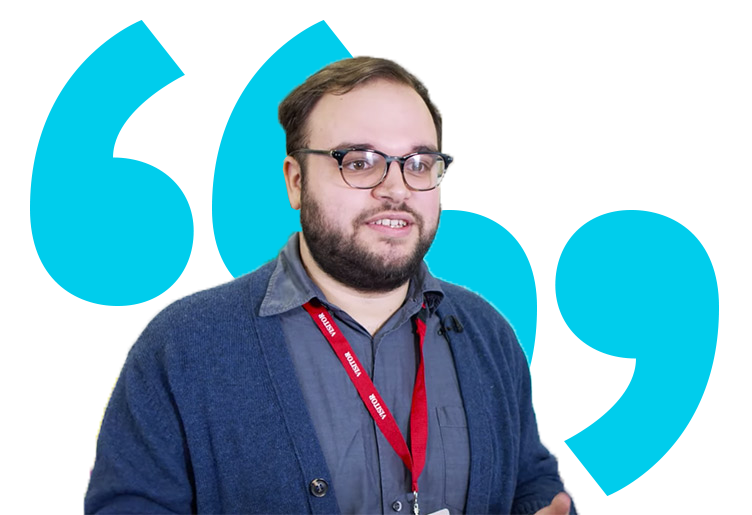"Don’t be put off, or don’t be scared about not knowing enough of the technical side of things, it’s something that you will learn while you are doing the course and it’s something you will learn while you are in the job."Thomas Flower – PDGE student

And to give you a clearer picture of what’s involved, here’s a snapshot of the whole application process. Now take a closer look at each of the steps in more detail. Whether you are looking for undergraduate or postgraduate teacher training programmes in Scotland, you must apply through the UCAS Undergraduate scheme.
Qualifications
To teach in a Scottish school, you must have:
- completed a four-year undergraduate course in education
OR - completed an undergraduate course and then a one-year PGDE
OR - qualified outside of Scotland with equivalent qualifications
If you’re looking to study to become a teacher in Scotland, you will need to have a recognised qualification. All teacher education programmes in Scotland are university-led and there are currently 11 education institutions offering these Initial Teacher Education programmes.
University entry requirements
The higher education institutions currently offering Initial Education Programmes (ITE) in Scotland are listed below:
Edinburgh Napier University
Queen Margaret University
Royal Conservatoire of Scotland
University of Aberdeen
University of Dundee
University of Edinburgh
University of Glasgow
University of the Highlands and Islands
University of Stirling
University of Strathclyde
University of the West of Scotland
Each university will have different entry requirements. It’s best to check this out on the UCAS website On your search, make sure you filter by courses in Scotland.
Membership of the PVG Scheme
If you’re training to be a teacher in Scotland, you also need to be a member of the Protecting Vulnerable Groups (PVG) Scheme. Your university will ask you to complete a PVG Scheme application before your first school placement, and the General Teaching Council for Scotland will ask you to complete an Existing PVG Scheme Member application when you apply for provisional registration. You will need to complete an Existing PVG Scheme Member application each time you start working for a new employer. This ensures that GTC Scotland and your employer is informed should you be accused or convicted of an offence that may have a bearing on your fitness to teach.
- Once you have explored your course options and made sure you’re eligible, it’s a good idea to try and get some school experience.
- Some Initial Teacher Education providers may want you to have classroom experience before you begin teacher training. You can arrange school experience independently by contacting your local school.
- Although it’s not essential, if you can spend some time observing and helping out with lessons in a local school before you apply, it will help strengthen your application. You can use the experience in your personal statement, showing what you’ve gained from it and how it has increased your motivation to be a teacher.
You can choose up to five courses. Check that you have the right level of qualifications and experience.
You’ll need to provide personal details and a full education history – so make sure to have all your qualifications to hand!
You’ll need to write a 4000 character personal statement to support your application. You can use it to demonstrate your passion and commitment for teaching – and it’s your opportunity to express why you think you’ll make a great teacher.
Showcase your motivation, commitment and teaching potential, backing up your points with examples. Provide an insight into your personality, and write honestly and thoughtfully. Avoid clichés and use clear, correct and concise English.
Here are some things to think about when you write your personal statement:
- Why do you want to become a teacher?
- What skills do you have that will make you a good teacher?
- What experience do you have in working with children and young people?
- What appeals to you about working with them?
The ability to communicate well is something that the admissions team will look for. So spend some time crafting your statement, and perhaps ask a family member or a close friend to check through it with you. They might spot a typo that you’ve missed – or even point out some important strengths and good qualities that you might overlook.
Why choose you?
Ultimately, that’s the question your personal statement needs to answer. You don’t have to be the best, the brainiest, the fastest, the most this or that – you just need to be you. Teachers come from all walks of life, all backgrounds, and are a mix of personalities – there are no right answers, just genuine ones. You are unique. So be yourself.
It’s a good idea to finish with a summary of what you have to offer. Leave the admissions team with a clear understanding of why you’d make a great candidate for the university course, as well as being an excellent teacher.
How to choose a referee
- They should be someone who knows you academically – for example, a teacher, tutor, lecturer or principal.
- If you’ve been out of education for a period of time, ask your employer or anyone who knows you in a work capacity.
- You want the reference to speak to your academic skills and character, so make sure to choose a teacher or employer who knows you well.
- Don’t ask family and friends as this could result in your application being cancelled.
How the reference should be written
Your referee must write a full reference, in English. Ask your referee to include your work experience, career goals, and any relevant personal skills that they feel would make you a good candidate, and ultimately a good teacher.
UCAS have lots of great tips for referees on how to provide a great reference. Find out more.
Once you’ve submitted your application, sit tight. You can check your progress through UCAS – but in the meantime, it’s worth preparing for your interview.
Some tips to prepare for your interview:
At your interview you’ll need to give confident, committed reasons why you want to teach. Think these through, write them down – and say them out loud! And remember, your interviewers want you to succeed – this is your chance to shine.
- Explain how you can make a difference as a teacher.
- Talk about what you can bring to the course you’re applying for – your subject knowledge and your ‘fit’ with the values of the school or university leading your training. Do your homework!
- Show how your skills from any previous employment will transfer to teaching.
- Be clear that you understand current policies and practices in education, and teaching in general.
- Be prepared for anything that might be asked of you, so you can rise to the challenge and make a great impression.
Other things to consider
Applying through Clearing, or direct to your chosen university
Clearing is how universities fill any places they still have on their courses. If you’re applying through Clearing, the best way to find out what to do, and how to apply, is through UCAS.
For most full-time undergraduate courses, you will need to apply through UCAS. However, if you’re applying for a part-time course, you may be able to apply directly to the university through their online application process.
Many universities in Scotland manage their own applications for postgraduate study, so please check on the website of the university and department you wish to apply for. You can also apply for postgraduate study at some universities through the UCAS Postgraduate website.
Your probationary period
When you’ve completed your ITE, and before you’re gained full registration status, you’ll enter your probationary period.
You can complete this in one of two ways:
- The Teacher Induction Scheme ensures a one-year teaching post in a local Scottish authority for all students who have recently obtained their teaching qualifications from a Scottish university. You’ll be allocated a post in one of five authorities of your choice.
- The flexible route is for students who – for example – can’t commit to a full-time position. This route allows you up to five years to complete your probationary period. You’ll document your professional development, which can take the form of supply teaching, teaching in the Scottish independent sector or teaching outside of Scotland.
It can pay to be open-minded
If you’re willing to complete your probation anywhere in Scotland, you could receive a preference waiver payment of up to £8,000. Alternatively, you can choose five locations, and list these in order of preference.
Costs and tuition fees, funding and support
As well as financial help with tuition fees, there are a number of loans and bursaries available to help cover living expenses. To find out more about the costs involved, and the funding that’s available to support you on your journey to becoming a teacher, visit Student Information Scotland.

